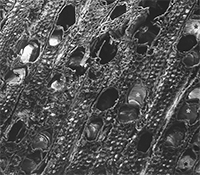Scanning and transmission electron microscopy in cultural heritage: State of the art

All claims expressed in this article are solely those of the authors and do not necessarily represent those of their affiliated organizations, or those of the publisher, the editors and the reviewers. Any product that may be evaluated in this article or claim that may be made by its manufacturer is not guaranteed or endorsed by the publisher.
The aim of this review is to analyse and report the importance of scanning and transmission electron microscopy applied to cultural heritage. Even if a lot of work has been carried out by chemical and microanalytical methods, the contribute of the morphological study has been only recently focused. In particular, scanning electron microscopy (SEM), requiring easier specimen preparations, has been widely applied to the study of ancient wood, textiles, metal or lithic objects, giving precious information on their surface details, manufacturing or possible contaminating agents. On the other hand, transmission electron microscopy (TEM) analysis, more difficult due to sample embedding and sectioning, can provide important details mainly on wood and textile samples. Both techniques are becoming progressively more useful for both cultural heritage study and diagnostic.
PAGEPress has chosen to apply the Creative Commons Attribution NonCommercial 4.0 International License (CC BY-NC 4.0) to all manuscripts to be published.
An Open Access Publication is one that meets the following two conditions:
- the author(s) and copyright holder(s) grant(s) to all users a free, irrevocable, worldwide, perpetual right of access to, and a license to copy, use, distribute, transmit and display the work publicly and to make and distribute derivative works, in any digital medium for any responsible purpose, subject to proper attribution of authorship, as well as the right to make small numbers of printed copies for their personal use.
- a complete version of the work and all supplemental materials, including a copy of the permission as stated above, in a suitable standard electronic format is deposited immediately upon initial publication in at least one online repository that is supported by an academic institution, scholarly society, government agency, or other well-established organization that seeks to enable open access, unrestricted distribution, interoperability, and long-term archiving.
Authors who publish with this journal agree to the following terms:
- Authors retain copyright and grant the journal right of first publication with the work simultaneously licensed under a Creative Commons Attribution License that allows others to share the work with an acknowledgement of the work's authorship and initial publication in this journal.
- Authors are able to enter into separate, additional contractual arrangements for the non-exclusive distribution of the journal's published version of the work (e.g., post it to an institutional repository or publish it in a book), with an acknowledgement of its initial publication in this journal.
- Authors are permitted and encouraged to post their work online (e.g., in institutional repositories or on their website) prior to and during the submission process, as it can lead to productive exchanges, as well as earlier and greater citation of published work.


 https://doi.org/10.4081/microscopie.2020.9183
https://doi.org/10.4081/microscopie.2020.9183



